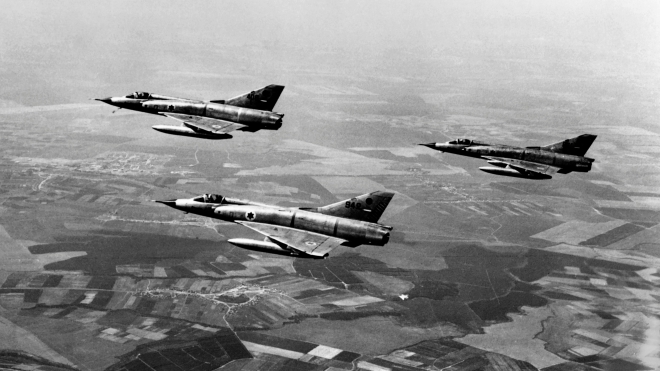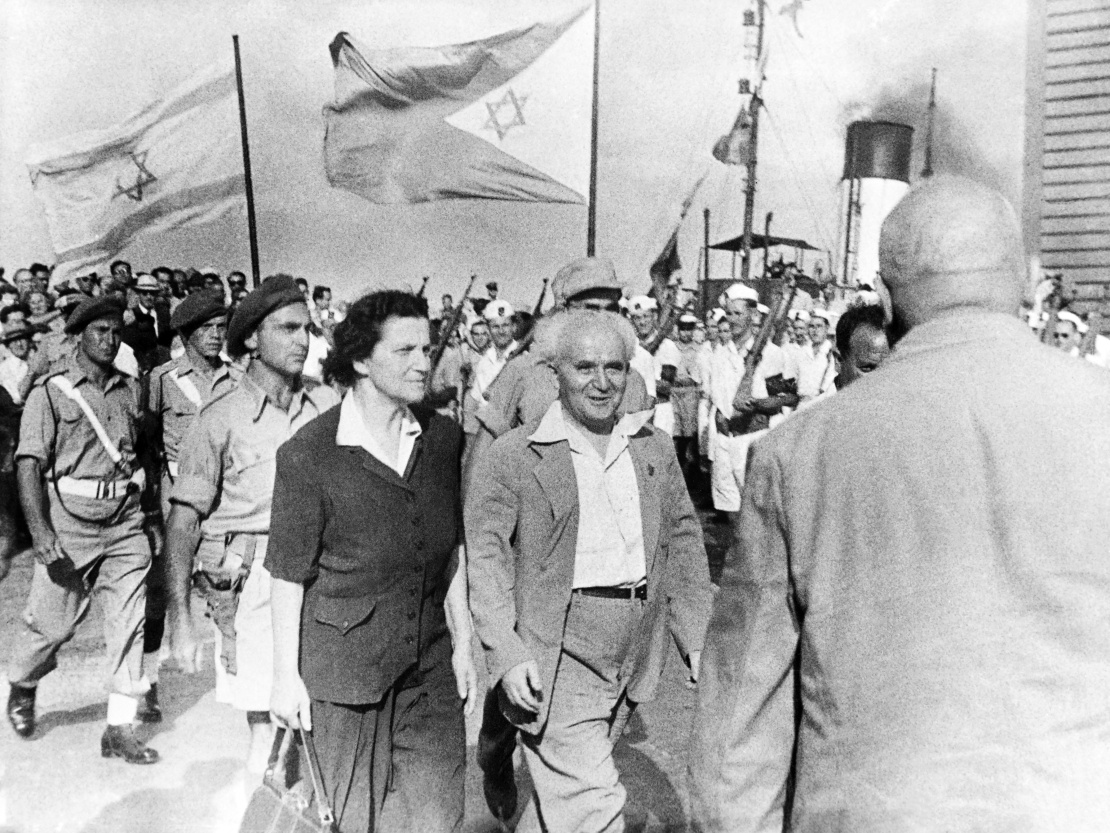The current Arab-Israeli conflict actually began the moment Israel declared its independence in 1948. The Six-Day War in 1967 became the next major military confrontation after the Suez Crisis of 1956-1957. Then Egypt informed about the nationalization of the Suez Canal, in response the Israeli army, supported by France and Great Britain, captured the Sinai Peninsula. However, under the pressure of the USSR and the USA, Israel retreated from the captured territories, and UN peacekeepers appeared on the Egyptian-Israeli border on the peninsula.
The first prime minister of Israel David Ben-Gurion and his wife Paula in Haifa harbor a month and a half after the declaration of Israelʼs independence on June 30, 1948.
After the Caribbean Crisis of 1962, the Soviet Union did not dare to interfere in an open confrontation with Western countries. However, it continued to compete with them for influence in various regions around the world, particularly in the Middle East.
In this case, the West supported Israel, and the USSR supported the Arab countries (primarily Egypt). In 1952, after a military coup in Egypt, Gamal Abdel Nasser came to power. He became close to the Soviet Union, and in return he received a lot of financial aid, grain and other goods. Soviet engineers built the Aswan Dam, large factories and other industrial enterprises. But the main thing is that the USSR sent weapons, military equipment and a group of military specialists to Egypt, who advised the Egyptian army in its confrontation with Israel until the 1970s.
In 1966, a Soviet squadron consisting of three dozen ships, including submarines equipped with nuclear missiles, went to the Mediterranean Sea. Deputy Minister of Defense of the USSR Andrii Grechko arrived in Cairo and assured the Egyptian military commanders of the "unwavering support of the Soviet government." In this way Egypt received Soviet nuclear protection.
Soviet leader Nikita Khrushchev (left) and Egyptian President Gamal Abdel Nasser, 1960.
During the 1960s, relations between Israel and its Arab neighbors deteriorated to the point that there were a number of border collisions, mostly on the Syrian border. In May 1967, the situation around Israel escalated as a result of Soviet disinformation that its troops were preparing an attack on Syria.
On May 18, Egypt ordered the withdrawal of UN peacekeepers from the Sinai Peninsula and blocked Israeli shipping lanes through the Red Sea. After the withdrawal of the UN forces, the Cairo radio broadcast the following message: "From now on, there is no longer an international emergency force protecting Israel. We will no longer hold back. We will no longer appeal to the UN with complaints about Israel. The only method of influence we will use against Israel will be a total war that will destroy the Zionist state."
UN peacekeepers in the Arab-Israeli conflict zone, 1967.
In late May, Egypt, Jordan, Iraq, and Syria formed a coalition and planned to "drove the Jews into the sea," as Egyptian leader Abdel Nasser called. Also, Algeria, Lebanon, Saudi Arabia and Kuwait sent their help against Israel. Preliminary, May 27 was even set as the date of the attack. However, Israeli intelligence learned about it very quickly.
However, Soviet analysts developed a different plan. Israel had to be provoked to strike first, to declare it an "aggressor" and deprive it of international support. And then decide the outcome of the war in their favor due to the numerical superiority of troops and equipment, as well as due to the fact that Israel would have to fight on several fronts.
The first part of the plan worked. Western countries condemned the naval blockade. However, when Israeli Foreign Minister Abba Even went to the USA, Great Britain and France, he realized that the West would not provide any real aid. And French President Charles de Gaulle demanded in an ultimatum that Israel not be the first to start military operations.
Demonstration in support of Israel in Paris on the second day of the Six-Day War, June 6, 1967.
However, the second part of the plan failed completely. The fact is that Soviet analysts were stuck in the standarts of the World War II. Therefore, they expected, for example, that something like the Battle of the Kursk would unfold in Sinai — a headlong collision of massive infantry and armored units operating on a wide front.
A group of Soviet military advisers in Egypt, early 1970s.
Wikimedia
The Israeli government hesitated until the end between a military and a political solution to the conflict. On June 3, Defense Minister Moshe Dayan gave a press conference where he stated that there will be no war in the near future. And the very next day, the government voted to "resort to military action, the purpose of which is to liberate the ring that is tightening around Israel." Instead of acting according to the logic of Soviet experts, the Israelis made an unexpected move.
Israeli Prime Minister Levi Eshkol (center) during the Six-Day War, 1967.
On June 5 at 07:00 Israeli time, 40 planes took off from Israeli airfields and headed west towards the Mediterranean Sea. No one paid attention to this, because since 1965, such flights took place according to the same scheme — 40 planes went towards the sea, descended sharply and returned to their airfields. However, this time it was different. The Israeli planes disappeared from the radar, and then at 07:45 suddenly appeared over the Egyptian military airfields and bombed the airstrips, destroying the fighters and bombers stationed there. This was the beginning of the "Moked" operation (from Hebrew — מבצע מוקד, which means concentration, focus).
Destroyed Egyptian warplanes at Al-Arish Airfield after an Israeli airstrike on the first day of the Six-Day War, June 5, 1967.
Here are the main factors for the success of the operation:
- Overwhelming secrecy — even members of the Israeli government did not know the exact time of the start of the attack, and the pilots were told about the upcoming operation only at 04:20 on June 5.
- Unexpected time — air raids are usually carried out before dawn, but the Israelis attacked twice: at 07:45 and at 10:00, when the vigilance and security of the air bases were weakened. The Egyptian patrol planes finished duty at 07:40, so most of the pilots were in the dining room at the time of the attack.
- Attack Vector — The Israeli Air Force came in from the north and west, which came as an unexpected move to the Egyptians, who were expecting airstrikes from Israel. Over the Mediterranean Sea, Israeli planes moved at an extremely low altitude — inaccessible to radars — and kept complete radio silence.
- Tactical preparation — the attack was well coordinated. The first strikes were made on the airstrips, preventing the enemyʼs planes from taking off. Attacks on airfields were carried out by small forces — four planes (double two) for each. Israel had been preparing for such an operation since 1962, gathering intelligence on Egyptian airfields and training its pilots to fly at low altitudes and bomb airstrips on specially built models in the desert.
- Technical training — at the time of the Six-Day War, all Israeli aircraft were of French production, but the Israelis developed combat equipment themselves. For example, new gyroscopic sights, which improved the accuracy of hitting even from long distances, and special penetrating bombs. During the attack, the pilots dropped them at the intersection of the airstrips — in this way, one bomb destroyed two airstrips at once.
Israeli soldiers pose with a portrait of Egyptian President Gamal Abdel Nasser, who was defeated in the Six-Day War, June 1967.
The uncoordinated actions of the Arab troops served a certain purpose. For example, the Egyptians informed their allies that they destroyed the Israeli air force and went on the offensive. And the reality, according to the eyewitness of those developments — the then attache of the USSR Embassy in Egypt Serhiy Tarasenko — was as follows: "Within an hour [after the Israeli airstrike], we already understood what was happening. A group of Soviet specialists who worked at the largest Egyptian base Cairo West arrived at the embassy. The look they had spoke volumes: dirty torn clothes, wasted faces. When we asked them what happened, the senior officer briefly said that Egypt no longer has an air force, and the Cairo West base is gone."
During two airstrikes on Egyptian bases, 304 aircraft were destroyed, and almost all on the ground. Israel lost nine aircraft, and six more were seriously damaged. And as a result of an Israeli airstrike on Jordanian and Syrian air force bases at 12:45 on the same day, all 28 planes of the Jordanian air force and about half of the Syrian air force — 53 planes at all — were destroyed.
The success of the "Moked" operation allowed Israel to gain air superiority and bomb enemy ground units over the next few days. It entered military historiography as a classic case of a preventive strike.
As a result of the war, Israel took control of territories that exceeded its pre-war area by approximately 3.5 times. Syria lost the Golan Heights, Egypt lost the Sinai Peninsula and the Gaza Strip, and Jordan lost the West Bank of the Jordan River. However, the peace did not last for long. In March 1969, Egypt started a new war. But this time the main goal was not to destroy Israel, but at least to return the territories lost in the Six-Day War.
Territories that came under Israeli control after victory in the 1967 Six-Day War.
We are counting on your unexpected donation for Babel: 🔸 in hryvnia , 🔸 in cryptocurrency , 🔸 Patreon , 🔸 PayPal: [email protected].

